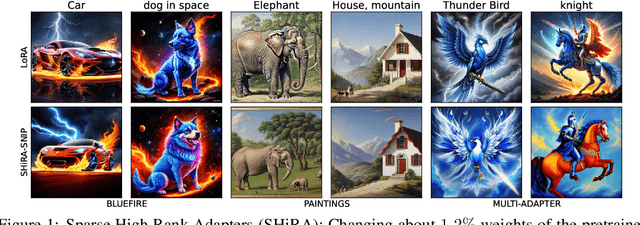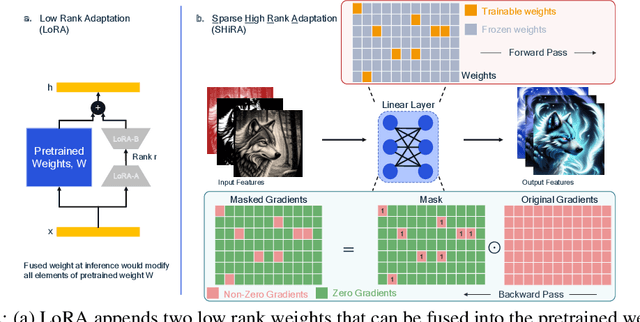Paul Whatmough
STaMP: Sequence Transformation and Mixed Precision for Low-Precision Activation Quantization
Oct 30, 2025Abstract:Quantization is the key method for reducing inference latency, power and memory footprint of generative AI models. However, accuracy often degrades sharply when activations are quantized below eight bits. Recent work suggests that invertible linear transformations (e.g. rotations) can aid quantization, by reparameterizing feature channels and weights. In this paper, we propose \textit{Sequence Transformation and Mixed Precision} (STaMP) quantization, a novel strategy that applies linear transformations along the \textit{sequence} dimension to exploit the strong local correlation in language and visual data. By keeping a small number of tokens in each intermediate activation at higher precision, we can maintain model accuracy at lower (average) activations bit-widths. We evaluate STaMP on recent LVM and LLM architectures, demonstrating that it significantly improves low bit width activation quantization and complements established activation and weight quantization methods including recent feature transformations.
HadaNorm: Diffusion Transformer Quantization through Mean-Centered Transformations
Jun 11, 2025Abstract:Diffusion models represent the cutting edge in image generation, but their high memory and computational demands hinder deployment on resource-constrained devices. Post-Training Quantization (PTQ) offers a promising solution by reducing the bitwidth of matrix operations. However, standard PTQ methods struggle with outliers, and achieving higher compression often requires transforming model weights and activations before quantization. In this work, we propose HadaNorm, a novel linear transformation that extends existing approaches and effectively mitigates outliers by normalizing activations feature channels before applying Hadamard transformations, enabling more aggressive activation quantization. We demonstrate that HadaNorm consistently reduces quantization error across the various components of transformer blocks, achieving superior efficiency-performance trade-offs when compared to state-of-the-art methods.
FPTQuant: Function-Preserving Transforms for LLM Quantization
Jun 05, 2025Abstract:Large language models (LLMs) require substantial compute, and thus energy, at inference time. While quantizing weights and activations is effective at improving efficiency, naive quantization of LLMs can significantly degrade performance due to large magnitude outliers. This paper describes FPTQuant, which introduces four novel, lightweight, and expressive function-preserving transforms (FPTs) to facilitate quantization of transformers: (1) a mergeable pre-RoPE transform for queries and keys, (2) a mergeable transform for values, (3) a mergeable scaling transform within the MLP block, and (4) a cheap, dynamic scaling transform. By leveraging the equivariances and independencies inherent to canonical transformer operation, we designed these FPTs to maintain the model's function while shaping the intermediate activation distributions to be more quantization friendly. FPTQuant requires no custom kernels and adds virtually no overhead during inference. The FPTs are trained both locally to reduce outliers, and end-to-end such that the outputs of the quantized and full-precision models match. FPTQuant enables static INT4 quantization with minimal overhead and shows SOTA speed-up of up to 3.9 times over FP. Empirically, FPTQuant has an excellent accuracy-speed trade-off -- it is performing on par or exceeding most prior work and only shows slightly lower accuracy compared to a method that is up to 29% slower.
Efficient LLM Inference using Dynamic Input Pruning and Cache-Aware Masking
Dec 02, 2024



Abstract:While mobile devices provide ever more compute power, improvements in DRAM bandwidth are much slower. This is unfortunate for large language model (LLM) token generation, which is heavily memory-bound. Previous work has proposed to leverage natural dynamic activation sparsity in ReLU-activated LLMs to reduce effective DRAM bandwidth per token. However, more recent LLMs use SwiGLU instead of ReLU, which result in little inherent sparsity. While SwiGLU activations can be pruned based on magnitude, the resulting sparsity patterns are difficult to predict, rendering previous approaches ineffective. To circumvent this issue, our work introduces Dynamic Input Pruning (DIP): a predictor-free dynamic sparsification approach, which preserves accuracy with minimal fine-tuning. DIP can further use lightweight LoRA adapters to regain some performance lost during sparsification. Lastly, we describe a novel cache-aware masking strategy, which considers the cache state and activation magnitude to further increase cache hit rate, improving LLM token rate on mobile devices. DIP outperforms other methods in terms of accuracy, memory and throughput trade-offs across simulated hardware settings. On Phi-3-Medium, DIP achieves a 46% reduction in memory and 40% increase in throughput with $<$ 0.1 loss in perplexity.
Mixture of Cache-Conditional Experts for Efficient Mobile Device Inference
Nov 27, 2024



Abstract:Mixture of Experts (MoE) LLMs have recently gained attention for their ability to enhance performance by selectively engaging specialized subnetworks or "experts" for each input. However, deploying MoEs on memory-constrained devices remains challenging, particularly when generating tokens sequentially with a batch size of one, as opposed to typical high-throughput settings involving long sequences or large batches. In this work, we optimize MoE on memory-constrained devices where only a subset of expert weights fit in DRAM. We introduce a novel cache-aware routing strategy that leverages expert reuse during token generation to improve cache locality. We evaluate our approach on language modeling, MMLU, and GSM8K benchmarks and present on-device results demonstrating 2$\times$ speedups on mobile devices, offering a flexible, training-free solution to extend MoE's applicability across real-world applications.
Rapid Switching and Multi-Adapter Fusion via Sparse High Rank Adapters
Jul 22, 2024



Abstract:In this paper, we propose Sparse High Rank Adapters (SHiRA) that directly finetune 1-2% of the base model weights while leaving others unchanged, thus, resulting in a highly sparse adapter. This high sparsity incurs no inference overhead, enables rapid switching directly in the fused mode, and significantly reduces concept-loss during multi-adapter fusion. Our extensive experiments on LVMs and LLMs demonstrate that finetuning merely 1-2% parameters in the base model is sufficient for many adapter tasks and significantly outperforms Low Rank Adaptation (LoRA). We also show that SHiRA is orthogonal to advanced LoRA methods such as DoRA and can be easily combined with existing techniques.
Sparse High Rank Adapters
Jun 19, 2024



Abstract:Low Rank Adaptation (LoRA) has gained massive attention in the recent generative AI research. One of the main advantages of LoRA is its ability to be fused with pretrained models adding no overhead during inference. However, from a mobile deployment standpoint, we can either avoid inference overhead in the fused mode but lose the ability to switch adapters rapidly, or suffer significant (up to 30% higher) inference latency while enabling rapid switching in the unfused mode. LoRA also exhibits concept-loss when multiple adapters are used concurrently. In this paper, we propose Sparse High Rank Adapters (SHiRA), a new paradigm which incurs no inference overhead, enables rapid switching, and significantly reduces concept-loss. Specifically, SHiRA can be trained by directly tuning only 1-2% of the base model weights while leaving others unchanged. This results in a highly sparse adapter which can be switched directly in the fused mode. We further provide theoretical and empirical insights on how high sparsity in SHiRA can aid multi-adapter fusion by reducing concept loss. Our extensive experiments on LVMs and LLMs demonstrate that finetuning only a small fraction of the parameters in the base model is sufficient for many tasks while enabling both rapid switching and multi-adapter fusion. Finally, we provide a latency- and memory-efficient SHiRA implementation based on Parameter-Efficient Finetuning (PEFT) Library. This implementation trains at nearly the same speed as LoRA while consuming lower peak GPU memory, thus making SHiRA easy to adopt for practical use cases.
Characterizing Soft-Error Resiliency in Arm's Ethos-U55 Embedded Machine Learning Accelerator
Apr 14, 2024



Abstract:As Neural Processing Units (NPU) or accelerators are increasingly deployed in a variety of applications including safety critical applications such as autonomous vehicle, and medical imaging, it is critical to understand the fault-tolerance nature of the NPUs. We present a reliability study of Arm's Ethos-U55, an important industrial-scale NPU being utilised in embedded and IoT applications. We perform large scale RTL-level fault injections to characterize Ethos-U55 against the Automotive Safety Integrity Level D (ASIL-D) resiliency standard commonly used for safety-critical applications such as autonomous vehicles. We show that, under soft errors, all four configurations of the NPU fall short of the required level of resiliency for a variety of neural networks running on the NPU. We show that it is possible to meet the ASIL-D level resiliency without resorting to conventional strategies like Dual Core Lock Step (DCLS) that has an area overhead of 100%. We achieve so through selective protection, where hardware structures are selectively protected (e.g., duplicated, hardened) based on their sensitivity to soft errors and their silicon areas. To identify the optimal configuration that minimizes the area overhead while meeting the ASIL-D standard, the main challenge is the large search space associated with the time-consuming RTL simulation. To address this challenge, we present a statistical analysis tool that is validated against Arm silicon and that allows us to quickly navigate hundreds of billions of fault sites without exhaustive RTL fault injections. We show that by carefully duplicating a small fraction of the functional blocks and hardening the Flops in other blocks meets the ASIL-D safety standard while introducing an area overhead of only 38%.
GPTVQ: The Blessing of Dimensionality for LLM Quantization
Feb 23, 2024



Abstract:In this work we show that the size versus accuracy trade-off of neural network quantization can be significantly improved by increasing the quantization dimensionality. We propose the GPTVQ method, a new fast method for post-training vector quantization (VQ) that scales well to Large Language Models (LLMs). Our method interleaves quantization of one or more columns with updates to the remaining unquantized weights, using information from the Hessian of the per-layer output reconstruction MSE. Quantization codebooks are initialized using an efficient data-aware version of the EM algorithm. The codebooks are then updated, and further compressed by using integer quantization and SVD-based compression. GPTVQ establishes a new state-of-the art in the size vs accuracy trade-offs on a wide range of LLMs such as Llama-v2 and Mistral. Furthermore, our method is efficient: on a single H100 it takes between 3 and 11 hours to process a Llamav2-70B model, depending on quantization setting. Lastly, with on-device timings for VQ decompression on a mobile CPU we show that VQ leads to improved latency compared to using a 4-bit integer format.
PerfSAGE: Generalized Inference Performance Predictor for Arbitrary Deep Learning Models on Edge Devices
Jan 26, 2023Abstract:The ability to accurately predict deep neural network (DNN) inference performance metrics, such as latency, power, and memory footprint, for an arbitrary DNN on a target hardware platform is essential to the design of DNN based models. This ability is critical for the (manual or automatic) design, optimization, and deployment of practical DNNs for a specific hardware deployment platform. Unfortunately, these metrics are slow to evaluate using simulators (where available) and typically require measurement on the target hardware. This work describes PerfSAGE, a novel graph neural network (GNN) that predicts inference latency, energy, and memory footprint on an arbitrary DNN TFlite graph (TFL, 2017). In contrast, previously published performance predictors can only predict latency and are restricted to pre-defined construction rules or search spaces. This paper also describes the EdgeDLPerf dataset of 134,912 DNNs randomly sampled from four task search spaces and annotated with inference performance metrics from three edge hardware platforms. Using this dataset, we train PerfSAGE and provide experimental results that demonstrate state-of-the-art prediction accuracy with a Mean Absolute Percentage Error of <5% across all targets and model search spaces. These results: (1) Outperform previous state-of-art GNN-based predictors (Dudziak et al., 2020), (2) Accurately predict performance on accelerators (a shortfall of non-GNN-based predictors (Zhang et al., 2021)), and (3) Demonstrate predictions on arbitrary input graphs without modifications to the feature extractor.
 Add to Chrome
Add to Chrome Add to Firefox
Add to Firefox Add to Edge
Add to Edge